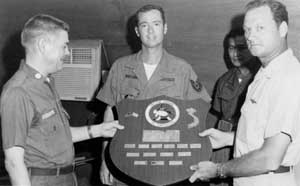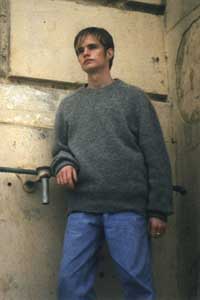-
- In a capital where the disgraced try everything to hang on, Foley exits in a hurry
- Could Wisconsin end 20-state winning streak for same-sex marriage bans?
- Disputed AIDS bill passes House
- Judge rules same-sex R.I. couples can marry in Massachusetts
- Conn. gay rights group backs DeStefano over Rell
- Transgender inmate fakes own death
- National News Briefs
- World News Briefs
feature
Celebrating a rich and triumphant history
Published Thursday, 05-Oct-2006 in issue 980
Gay History Month began as a direct result of the lack of gay and lesbian history in textbooks. In 1994, Rodney Wilson, a high school teacher in Missouri, along with other leaders and educators, started a campaign to educate the general public about the history of the GLBT community. Since then, many prominent groups have endorsed October as Gay History Month, along with several state and city governments.
In celebration, leaders of the gay press have come together to raise awareness of those who fought for all the rights and privileges we enjoy today, and gave us all reason to dedicate this month to them. All of us involved with the project hope that sharing their history will show a guiding light upon today’s paths that remain uncharted.
Starting this year, we’ll introduce you to some of those historic individuals who took us from secret meetings in apartments and clubs to the day in June in 1969 when one group finally said no to oppression and fought back against the police. Before and after Stonewall were different heroes who came out and led the community to the admirable heights it has reached today. This publication along with other leading GLBT publications from across the country voted on 12 people to honor as part of this year’s Gay History month
To help enlighten us further on specific facets of GLBT history, we’ve asked some of the most important, well-known and outspoken members of our community to point the way. We’re proud to bring you exclusive pieces including Academy Award writer Bruce Vilanch’s look at how we’ve been portrayed on the silver screen and famed TV writer Gail Shister’s views of our presence on the small tube. Tennis phenom Martina Navratilova gives a first-person view of sports and the coming out process, and, finally, we’ll see how the media hones in on a gay reality star and his well-known boyfriend with exclusive excerpts from “Amazing Race” winner Reichen Lehmkuhl’s book Here’s What We’ll Say.
Welcome to Gay History Month!
When Leonard Matlovich became the first openly gay man to grace the cover of Time on Sept. 8, 1975, his story had enlivened both the anti-gay military climate and the gay civil rights struggle. After coming out in March 1975, Matlovich was discharged from the Air Force after 12 years of impressive service, including three tours in Vietnam which resulted in a Bronze Star, Purple Heart and Air Force Commendation Medal. The 32-year-old fought against the ruling, taking the case up to the U.S. Court of Appeals, which began a firestorm in press and political circles. A program about his case, Sergeant Matlovich vs. the U.S. Air Force, was aired by NBC as one of the first gay feature stories on broadcast television. Matlovich also graced the covers of multiple national media outlets, including Time. The Court of Appeals eventually overturned the lower court decision to uphold the discharge, and subsequent proceedings led to ordering the sergeant’s reinstatement and $62,000 in back pay. However, the court ruled not on the constitutionality of the discharge itself but the Air Force’s failure to clarify its reasoning. Rather than return to military service, Matlovich decided to accept an honorable discharge and a $160,000 tax-free settlement. He entered the civilian world and moved to San Francisco, where he lived as ensuing events unfolded. He took a strong conservative stance during the AIDS epidemic, campaigning against bathhouse culture and creating a gay conservative organization in Washington, D.C. In 1986, Matlovich was diagnosed with AIDS and spent his remaining years as an activist until his death at 45 in 1988. He was given full military honors and a 21-gun salute at the Congressional Cemetery in Washington, D.C. His tombstone sits as a memorial to all gay and lesbian service members, reading “A Gay Vietnam Veteran” in place of his name. Another famous line adorns the stone, one that echoes in the gay and military communities still today: “When I was in the military they gave me a medal for killing two men and a discharge for loving one.”
On July 4, 1965, Barbara Gittings picketed outside the steps of Independence Hall in Philadelphia, brandishing a sign which read: “Homosexuals should be judged as individuals.” But her work as an activist goes far beyond that first protest. More than 43 years in the civil rights movement saw Gittings make an impact on the medical, literary and media industries. She is a founding member of the New York chapter of the early lesbian group Daughters of Bilitis and a former editor of the DOB’s national magazine, The Ladder. Her tenure at The Ladder led to a shift in values of the organization toward direct action, a concept which Gittings implemented in her struggle with the American Psychiatric Association. Gittings joined Frank Kameny in the campaign against the APA’s classification of homosexuality as a mental illness, a battle which included a rogue exhibit at the 1971 convention and participation in several APA panels. The campaign’s goal was realized in 1973, when the board of trustees agreed on homosexuality’s removal from the list of disorders. And, in perhaps her most notable contribution as a pioneer, Gittings’ work with the American Library Association dramatically increased the availability and proliferation of GLBT-themed works for mass consumption. The Gay Bibliography began with 37 positive titles on gay topics, and now has hundreds of titles in numerous categories. As a further step to increase GLBT visibility in literature, she also led the ALA’s Task Force on Gay Liberation to present the first Gay Book Award in 1975, which was adopted as an official award by the ALA in 1986. In 2001, the Gay & Lesbian Alliance Against Defamation honored Gittings with the very first Barbara Gittings Award for activism. Along with her partner, fellow activist Kay Lahusen, she continues her community activities and is widely recognized for all her historic efforts.
When Aaron McKinney was awaiting sentencing for the murder of 21-year-old Matthew Shepard in Laramie, Wyo., Shepard’s father, Dennis, asked the court to spare McKinney the death penalty and instead impose a double-life sentence without parole. The elder Shepard said in his statement to the court: “Mr. McKinney, I give you life in the memory of one who no longer lives. May you have a long life, and may you thank Matthew every day for it.” In the same spirit of compassion, Dennis and Judy Shepard have become noteworthy allies of the GLBT community, rallying behind hate-crimes legislation across the country and establishing the Matthew Shepard Foundation, which educates and informs the public about discrimination and promoting diversity. The foundation also serves as the vehicle for Judy Shepard’s public-speaking program, which educates individuals about the development and elimination of hate speech and behavior. Her son has become an icon for the worldwide GLBT community and a symbol of how discrimination can undermine the very fabric which brings humanity together. Matthew Shepard cared about people and strove for equal judgment and equality with everyone he met. According to his father: “He didn’t see size, race, intelligence, sex, religion or the hundred other things that people use to make choices about people. All he saw was the person.” Indeed, Shepard’s story has inspired communities of all kinds, and, along with his parents, several notable individuals have commended the youth’s ideas and created numerous tributes to him. Melissa Etheridge wrote the song “Scarecrow,” a reference to the jogger who originally found the beaten Shepard tied to a fence, thinking the young man a scarecrow at first. Playwright Moises Kaufman wrote The Laramie Project, which has become a staple of American theater and spawned an HBO movie. And MTV released the film Anatomy of a Hate Crime followed by 18 hours of dead air, a tribute to the time Shepard spent on the fence suffering from brain trauma, head fractures and hypothermia. The image of the fair Shepard has become ingrained in gay history, and the tragedy of his promising life cut short by such brutality has inspired not just a nation but a world toward hope and tolerance.
|
|
Copyright © 2003-2025 Uptown Publications




